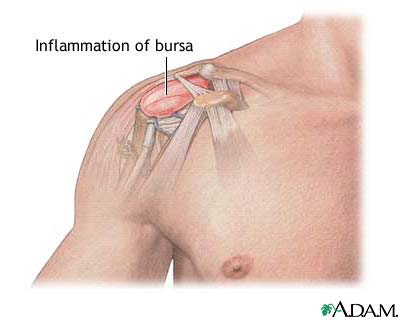Brief Outline of Shoulder Bursitis
Shoulder bursitis is not generally an isolated condition, but is usually associated with a rotator cuff tear, or impingement syndrome, and occurs when the region between the upper arm bone (humerus) and tip of the shoulder (acromionI) becomes inflamed. Tennis, baseball, and weight training are all prone to this injury.
Anatomy and physiology
Tendons of the rotator cuff act to rotate the upper humerus, raising the arm by pulling the humeral head down. At the same time, the deltoid muscle pulls the arm up. This process can lead to irritation due to pressure from the acromion process of the scapula and the coraco-acromial ligament. Such irritation can affect the bursae – fluid-filled sacs providing a cushion between the bones and the tendons – leading to inflammation and accumulation of excess fluid, further limiting the space available for tendon movement. The subacromial bursa is the largest and most commonly injured bursa in the shoulder region.
Cause of Shoulder Bursitis
Overuse of the shoulder from throwing activites, tennis, swimming or baseball. Falling onto an outstretched arm. Infection of the bursa in the shoulder.
Signs and symptoms for Shoulder Bursitis
Pain in the shoulder, particularly when raising the arm. Pain when turning over in bed on injured shoulder. Loss of strength and limited motion of the shoulder.
Treatment for Shoulder Bursitis
- Stop all activity causing inflammation of the shoulder
- Injection
- Shockwave therapy
Rehabilitation and prevention for Shoulder Bursitis
The athlete should avoid pressure to the injured shoulder and inflamed bursa(e) during recovery as well as any activities likely to irritate the condition. Begin exercising the shoulder when instructed by a medical professional in order to restore strength and shoulder mobility. Warming-up and cooling-down exercises, with an emphasis on stretching, strength training and maintaining looseness in the shoulder can help prevent bursitis from developing.
Long-term prognosis for Shoulder Bursitis
Shoulder bursitis tends to ease with proper healing and minor rehabilitation, and a full recovery to athletic activity can usually be expected, particularly if no infection of the bursa is detected. In some cases, aspiration of bursa fluid by needle is recommended to reduce inflammation and ensure no infection is present.
Shoulder Specialist Treating Shoulder Bursitis



